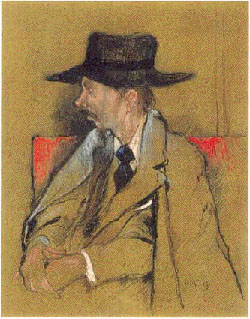|
From unpublished papers in the Hugh Walpole archives
Matthew Sturgis.
Amongst the Hugh Walpole papers in the Bodleian Library
at Oxford there is a small cache of material relating to Enoch Soames
that, as far as I know, has never been published before. It deserves
to be better known, not only for the light (dim enough) that it sheds
on Soames himself but also for its telling allusions to several other
figures of the period.
A pencil note by Walpole accompanying the documents—a
manuscript poem and three letters—indicates that he bought them
as a single lot from a Preston bookseller in 1923. The attached receipt
reveals that he paid 4/– for his discovery. Even at today’s
prices we may consider it was twenty pence well spent.
The poem is by Soames,
written in his hand, signed, and dated February 1894. The three letters
are from diverse authors, but once assembled into their chronological
order they tell their own tale readily enough, and it is perhaps best
to let the documents speak for themselves.
1.Manuscript poem in Soames’s
hand.
Mood: Gardenia and Black.
The scent of my buttonhole
Flowed and ebbed in the gloom;
It was close in the supper-room.
Close, and then, in the throng,
Sudden, a crash, a blow.
And a hand on my arm I know.
And then, through the dark, a rush,
Heady and vague; the flair
(A rose?) of the cold night air.2
Enoch Soames.
Paris/London Feb. ’94.
[1] The poem
does not appear in any of Soames’s three published collections,
and in many respects is something of a departure from his usual themes.
In tone it is a slightly strained attempt to assume the dandified pose
of Theodore Wratislaw or Herbert Horne, while the style, though touched
with Soames’s usual felicities of expression—“Flowed
and ebbed”, the “?” after “rose”—owes
perhaps too great a debt to Arthur Symons’s poem “Pastel—Masks
and Faces” to stand in the front rank of his achievement.
[2] Although, true to the precepts
of literary Impressionism, it is not entirely clear what the poem is
about, it seems to me to record the summary ejection of the poet from
some private party. The suggestive phrase “Heady and vague”—used
to describe his precipitous path from “supper-room” to “cold
night air” suggests—I think—both the poet’s condition
and the reason for his ejection.
2. Letter from Henry Harland.
144 Cromwell Road.
February 7, 1894.
My dear Soames,
Many thanks for your exemplary poem (herewith returned).
It is in many ways—too many to enumerate—admirable.
But for various reasons—too many to enumerate
also, but none of them connected with Art—I feel that it would
not be suitable for The Yellow Book—which, by-the-by,
we hope will establish itself as a leading family-periodical.
You are quite right that A[line] and I do sometimes
keep open house on Sat. evenings. And it would be a great pleasure for
us to see you at Cromwell Road. But we are currently planning a trip
over to Paris to visit Verlaine, and are rather unsure of our dates.
A bientôt,
Yours &c.
Henry Harland.
p.s. Aubrey was flattered by your notion of his illustrating
your dialogue between Pan and St. Wilgeforte, but
fears he must decline on health grounds.
[1] The address
of Henry Harland (1861–1918) and his wife Aline. The Harlands were
a sociable and literary American couple who had settled in London at
the beginning of the ’Nineties.
[2] The Yellow Book—the
characteristic periodical of the decade—was launched in April 1894;
John Lane (together with Elkin Mathews for its first two quarterly numbers)
was the publisher, Harland the literary editor and Aubrey Beardsley
(see below) the art editor.
[3] Aubrey Beardsley (1872–1898),
the brilliant young draughtsman, was, at the beginning of 1894, still
only on the verge of fame. The publication of his illustrations to Oscar
Wilde’s Salome at the end of February, and the arrival of The Yellow
Book in April, secured his reputation.
[4] This seems to be an error
on Harland’s part. Soames’s first book Negations contains
a dialogue between Pan and St. Ursula, and it is to this I suppose that
Harland is referring. There is, of course, the possibility that Soames
was working on a series of dialogues (now lost) between Pan and a whole
range of mediæval female saints.
[5] The reference is surprising,
as Beardsley’s health, although never strong, was generally good
in the first months of 1894.
Letter from W. E. Henley.
[Postmark 26 March ’94]
Offices of the National Observer.
The Editor.1
Dear Mr. Soames,
No! I do not recall meeting you at Gosse’s.
And No!! I do not want your poem. It seems to me a distillation of all
that is weakest and most morbid in current literature. Whibley
too tells me it is quite without merit.
Yours faithfully,
Henley.
[1] W. E. Henley
(1844–1903) was editor of the National Observer. He was also a
poet of considerable achievement—ironically in a mode that was
often cited as “impressionist”.
[2] Edmund Gosse (1849–1928),
civil servant, critic and author; he held literary receptions at his
house in Delamere Terrace.
[3] Charles Whibley (1860–1930)
was one of the brightest of Henley’s young journalists.
Letter from The Editor of Tit-Bits.
From the Offices of Tit-Bits.
2 May 1894.
Dear Sir,
Thank you for your poem—Mood: Geranium [sic] and
Black. You are to be congratulated on such a clever parody of the fin-de-siècle
strain in contemporary verse. Alas, the current editorial policy is
to ignore this “Oscar Wilde tendency” in all its forms. There
is a feeling, which I am sure you will recognise, that even to mock
it is to draw undue attention to it.
Should the editor alter his policy, however,
we would certainly be happy to reconsider your ingenious skit. But until
such time I am returning it to you, with my thanks.
Yours faithfully,
R. Nebley.
Assistant to the Asst. Editor.
|



